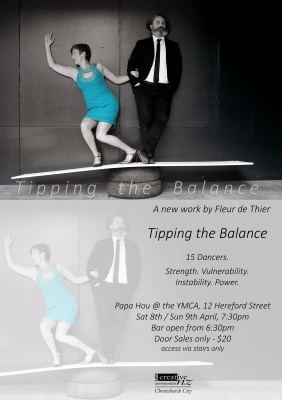TIPPING THE BALANCE
Papa Hou Theatre at the YMCA, 12 Hereford Street, Christchurch
08/04/2017 - 09/04/2017
Production Details
Tipping the Balance reflects the themes running through the last 7 years of Fleur de Thier’s work.
Rebound Dance Company and guest dancers perform with integrity and strength in this new show that explores space, concept and set.
Rebound is known for their highly entertaining dinner/theatre style shows. Now there is an opportunity to see them in a gritty and innovative contemporary dance work that plays with the balance between edgy dance and the grace that comes from being a maturing dancer.
Sat April 8 and Sun April 9 2017
7.30pm
Papa Hou @ YMCA, 12 Hereford Street, Christchurch
Bar open from 6.30 pm
Door sales only: $20
Dance ,
1 hour
Stamina and aplomb in working together
Review by Dr Ian Lochhead 11th Apr 2017
Over the last seven years Fleur de Thier has explored a wide range of contemporary experience through dance, ranging from the impact of the Christchurch earthquakes on peoples’ lives and, more recently, family rituals in Someone say “I do” and disorientation, both physical and psychic, in Anchor Points, both in 2016. Her latest work revisits these themes but with a new twist and using a cast of fifteen dancers, herself included. Staged in the large space of the YMCA’s former gymnasium, this is an ideal location for dance, with a wooden floor and tiered seating. Its size also allows for a new expansiveness that some of the more restricted spaces used for past performances could not accommodate.
There is no set but Sean James’s lighting design creates a series of spaces within an otherwise undifferentiated floor area. The performance begins with the cast lined along the back wall, locked in a series of illuminated ‘rooms’, pressed against the solid blockwork behind them. As the performance evolves within this shallow, light-defined space, a pattern emerges as pairs of dancers become the focus of attention while the remainder becomes a chorus who watch and react to the central action. Within this largely abstract framework, it is difficult for the audience to detect a clear line of development as solos and duets evolve from within the larger ensemble.
A clearer direction emerges when de Their introduces the props that have often played a key role in her works, in this case, rectangular panels of dense cardboard that are light, flexible and strong. They appear first as burdens on the backs of the dancers as they crawl in from the wings but are quickly transformed into a series of individual performing mats, only to be abandoned as groups of dancers coalesce on a few panels at the rear, a single individual remaining isolated at the front, a metaphor, perhaps, for the way communities form attachments that both support and exclude their members.
Increasingly the panels take on a more dynamic role; standing on end they become mirrors on which shadows hover, only to disappear as they flop to the floor. As human shadows dissolve identities seem to disappear with them. Rubber car tyres were used by de Their to great effect in 2011 to replicate the unsteady ground on which Cantabrians found themselves living, but now they have been given a different role. Tied together in pairs and with LED lights illuminating their centres, they become the new focus for the dancers, used as pedestals, thrones and even fashion accessories in the most light-hearted sequence of the evening. Yet the very instability of the tyres creates underlying tensions that are only increased when they become pivots for the panels that have been temporarily set aside. With dancers paired on each of these makeshift seesaws the possible permutations for tipping into chaos are unlimited, yet as they synchronise their movements to balance on their continually shifting platforms it becomes clear that only by working together can we remain upright here. In defying the ever-present possibility of over tipping the balance, the performance reaches its climax and conclusion.
Throughout the hour-long show, Rebound’s mature dancers respond to the challenges confronting them with stamina and aplomb, relishing the opportunities provided for individuality while remaining true to the larger framework of the work. If Tipping the Balance takes some time to find its direction, the final sequences bring it to an exhilarating close.
Copyright © in the review belongs to the reviewer





Comments